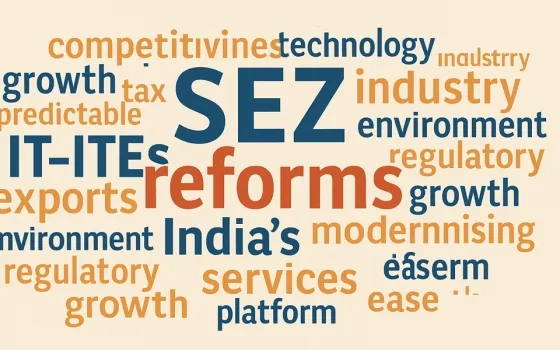- Introduction to SPAC
SPAC is a type of company that does not have an operating business and is formed with the specific objective of acquiring a target company. This concept allows a ‘shell company’ to raise capital through an Initial Public Offering (IPO), without having any commercial activity. After listing, the SPAC merges with or acquires a target company.
The stakeholders involved in SPAC are:
- Sponsors: these are professionals who initiate the SPAC procedure by creating a business and working with an underwriter to prepare the SPAC to go public through an IPO route. They are required to complete the acquisition within a prescribed period, depending on the laws of the country in which the SPAC is incorporated.
- Targets: these are the existing companies that a SPAC targets for merger or acquisition. Typically, target companies are startups who are looking at the possibility of going public.
SPACs are currently regulated and recognised across jurisdictions like the United Kingdom, United States of America, Canada, Singapore, and Malaysia. They are not currently recognised in India.
- Benefits of SPAC
- For a Sponsor: typically, sponsors would purchase equity in the SPAC at more favorable terms than investors in the IPO. This holding would eventually be converted into a respective stake in the target company. This becomes the sponsors’ motivation in finding an attractive target with immense potential value.
- For a target company:
- A SPAC purchase enables the target company to go public without having to undergo the process of and incur the expenses of hiring underwriters, multiple investor negotiations, overwhelming documentations, and filings, producing a prospectus etc. In a SPAC deal, the processes are undertaken by the SPAC and the expenses are lower than one would incur in a regular IPO.
- SPAC transactions also bring the benefit of accessing investors through the expertise of sponsors.
- SPAC acquisitions are conducted on predetermined prices, which are less vulnerable to the volatility in public markets, as opposed to traditional IPOs where price discovery is market driven.
- For a SPAC listing, targets have the advantage of marketing the company’s future projections to investors, which is particularly relevant for start-ups/high-growth companies. This is unlike traditional IPOs, where higher focus is placed on historical performance/track record of the company.
- For shareholders of target company: The potential of receiving multiplied returns through the securities market is a driving factor.
- Current regulatory regime
The current regulatory framework of India does not support SPAC structures. This can be inferred from the following:
- Companies Act, 2013 – Provisions under the Companies Act, 2013 mandatorily require a company to be incorporated with a business object. Further, companies are required to file the memorandum of association, which forms the basis of registration of a company. This may not be possible for SPACs since these are shell companies that are yet to identify a target and accomplish a business combination. Further, the Companies Act mandates Registrar of Companies to remove a company’s name if it fails to commence business within a period of 1 year from the date of incorporation. Typically, a SPAC is given 24 months to undertake the business combination which is extendable by a special shareholder resolution. This creates a significant barrier for SPACs in India.
- Securities Exchange Board of India (SEBI): As per Regulation 6 of SEBI (Issue of Capital and Disclosure Requirements) (Amendment) Regulations (SEBI ICDR Regulations), a company is required to fulfil certain eligibility criteria for listing (such as minimum net worth, net tangible assets, average operating profits, etc.). A SPAC entity will not be able to meet these criteria due to lack of operating income and net tangible assets.
A combination of the above existing legal and regulatory framework in India presents roadblocks for a SPAC to be incorporated in India.
However, there are indications that the Indian government and regulators are considering legalising SPACs in India:
- International Financial Services Centres Authority (IFSCA): IFSCA has formulated guidelines for listing of SPACs in International Financial Services Centres (IFSCs) vide issue of IFSCA (Issuance and Listing of Securities) Regulations, 2021 (IFSC Regulations). The IFSC Regulations recognise listing of SPACs in IFSCs and provide detailed regulations governing SPAC eligibility, offer timing, initial disclosures on the offer document, underwriting and other SPAC specific obligations.
- SEBI: There have been media reports suggesting that SEBI is planning to come out with a framework on SPACs, which will enable listing of startups on domestic stock exchanges
- CLC Report: The Companies Law Committee (Law Committee), constituted by the Ministry of Corporate Affairs (MCA) in 2019 released its report in March 2022. The Law Committee has recommended the following:
- Introduce an enabling provision in the Companies Act, 2013 to recognise SPACs
- Allow entrepreneurs to list a SPAC incorporated in India on domestic and global securities exchanges.
- Add provisions in Companies Act 2013, to relax the requirement to carry out business before the company gets struck-off.
- Add provisions in Companies Act 2013, to providing an exit option to dissenting shareholders of a SPAC if they disagree with the choice of the target company identified.
- Commencement of Section 23(3) and 23(4) of Companies Act 2013 is necessary to enable an Indian incorporated SPACs to list on foreign stock exchanges.
- Addressing potential risks associated with SPACs
Considering the above, SPACs are an attractive instrument to enable listing of companies, whether domestically or internationally. However, there may be certain risks associated with SPACs, such as:
- These companies have no assets other than the funds that they raise, which are market dependent, are based on the future of the company, and therefore can pose a higher risk, especially for retail investors.
- Decisions of a SPAC are solely in the hands of the sponsors, who may lack expertise in their target company’s market segment. This may lead to poor decisions or conflict between the SPAC sponsors and the owners of the company they are acquiring.
- Investments in SPACs may have a higher risk in terms of the uncertainty, as typically SPACs either do not disclose information on the identified target companies/ target industry or are mandated to act as per the disclosed information, at the time of IPO.
These risks can be managed with regulatory oversight and balanced regulations governing SPACs in India. For example, the following safeguards in the regulatory framework can be considered, such as, (1) mandating the sponsors of a SPAC to be sophisticated and seasoned group of investors; (2) prescribing a minimum percentage of post-issue paid up capital to be held by sponsors; (3) prescribing a maximum threshold on the percentage of total post-issue paid up capital that can be allotted to a single applicant; (4) giving opportunity to dissenting shareholders to redeem their investment in case investors do not approve the merger proposed by the SPAC sponsor; (5) prescribing framework for due-diligence, audits, financial reporting etc.
- Impact on start-ups, Indian companies, Indian securities market
It is noteworthy that the government in India is considering legalising SPACs and enabling their listing on foreign stock exchanges. We recognise that legalising SPACs requires an in-depth examination by Indian regulators into the potential risks and accordingly installing adequate safeguards in the regulatory framework.
We believe that legalising SPACs and allowing them to list on overseas stock exchanges can lead to enabling more options for Indian companies, especially start-ups, to attract capital. This can be one of the ways to enable overseas listing for start-ups, something that NASSCOM has recommended to the government on multiple occasions. This is likely to be welcomed by the start-up community, make India an attractive destination for entrepreneurs, thereby complementing India’s journey towards becoming the world’s largest startup hub.
This may also lead to strengthening India's securities regulations further, by putting in safeguards for potential abuse/mischief related to SPAC listings. This may make the Indian capital markets more trustworthy for investors and attract more capital (foreign and domestic) into the Indian economy.
- Contact Us
If you are interested in exploring this topic further with NASSCOM, please contact Garima Prakash (garima@nasscom.in), Tejasvi Gupta (tejasvi@nasscom.in) or Ashish Aggarwal (asaggarwal@nasscom.in).








![[UPDATE] Release of Guidelines for Examination of Computer-related Inventions (CRIs), 2025](https://community.nasscom.in/sites/default/files/styles/560_x_350/public/media/images/For%20Blog%20-nasscom%20public%20policy%20960%20x%20600%20png_14.png.webp?itok=TVoaAkX5)

